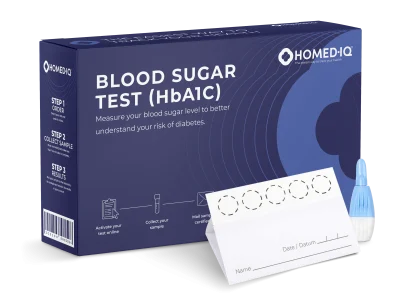When most people think of a blood sugar test, they envision someone pricking their finger several times a day, especially after eating something sweet or containing carbohydrates. But did you know there is more than one way to test your blood sugar, including checking your average blood sugar level over the past months? In this article, we will explain what HbA1c is, what it means, why it is important to test your HbA1c level, and how you can lower your HbA1c level.
With the Homed-IQ Blood Sugar Test (HbA1c), you can have your HbA1c tested from the comfort of your own home without having to make an appointment with your doctor.
What does HbA1c mean?
HbA1c is a blood test used for diagnosing and monitoring people with diabetes. HbA1c stands for glycated haemoglobin. HbA1c is produced when glucose attaches itself to the red blood cells in your body. The more glucose in your blood, the more HbA1c is produced.
An increased level of HbA1c means that you carry too much sugar in your bloodstream and you run into the risk of developing complications from diabetes. The longer you have high blood sugar levels, the higher your HbA1c test result will be (DiabetesUK, 2024).
On average, red blood cells can live for up to four months. Therefore, your HbA1c can be an indicator for how much sugar there has been in your blood over the past months. As such, Homed-IQ’s Home HbA1c test differs from a blood glucose test, which measures the amount of sugar in your blood at the moment of testing.
HbA1c levels
When using an HbA1c test for monitoring diabetes, most individuals must perform the test between two to four times a year. A woman that is planning on having a baby should do an HbA1c test more frequently, while the test is less often required later during pregnancy. Additionally, the HbA1c target level differs for people with type 1 diabetes or type 2 diabetes. Your HbA1c levels also vary for many reasons, such as:
- Changes in your lifestyle
- Stress
- Not feeling well
- Taking other medications, such as steroids
To have a frame of reference regarding what HbA1c level is normal, you need to put the HbA1c level (in %) in relation to your blood sugar level (mg/dL). A HbA1c level below 5.7% is considered normal, while a value of 6.5% or higher indicates diabetes. Levels between 6.0% and 6.4% can indicate pre-diabetes. If your HbA1c level exceeds 6.0%, it is advised to contact your general practitioner for advice.
| HbA1c (%) | Blood Sugar (mg/dL) |
| 4 | 97 |
| 5 | 126 |
| 6 | 154 |
| 7 | 183 |
| 8 | 212 |
How to lower HbA1c levels
Luckily, there several simple lifestyle changes you can make to lower your HbA1c level. If you take any medications, it is advised to talk to your general practitioner. You might consider adjusting your dose or even switching your medicine to bring down your HbA1c level. Other steps you can take are:
- Visit a local educational course about diabetes to learn more about it
- Exercise more
- Quit smoking
- Follow a balanced and healthy diet
The difference between an HbA1c test and blood sugar test
It is a common misconception that a HbA1c and a finger-prick blood sugar test are the same, but they’re not. Although they are both relevant for patients with diabetes, they measure something different. While the finger-prick blood sugar test measures the blood sugar level at the moment of testing, the HbA1c test measures the average blood sugar levels from the past 2-3 months. The finger-prick blood sugar test is a test designed to be used by individuals multiple times a day because they take specific medicines, such as insulin or sulfonylureas. The HbA1c test, on the other hand, is designed for anyone who has diabetes or prediabetes and is performed only two to four times a year to see how well the diabetes is being managed. Here at Homed-IQ, you can buy a HbA1c test that you can do easily at home.
-

Blood Sugar Test (HbA1c)
€45,00
Checking your HbA1c level even if you haven’t been diagnosed with diabetes is a good way to catch elevated blood sugar levels early before irreversible diabetes occurs. As pre-diabetes and early-stage type II diabetes can have little to no symptoms, monitoring your HbA1c can help you better understand your risk and make lifestyle changes as needed.
References
Diabetes UK. (n.d.). What is HbA1c? Retrieved 9 March 2022, from https://www.diabetes.org.uk/guide-to-diabetes/managing-your-diabetes/hba1c
Health Direct Australia. (2020, August 1). HbA1c test. Diagnosing and Monitoring Diabetes | Healthdirect. Retrieved 9 March 2022, from https://www.healthdirect.gov.au/hba1c-testEckelkamp, S. (2022, January 28). Managing Diabetes: What Is HbA1c And What Is A Normal Level? Imaware.Health. Retrieved 9 March 2022, from https://www.imaware.health/blog/what-is-hba1c





